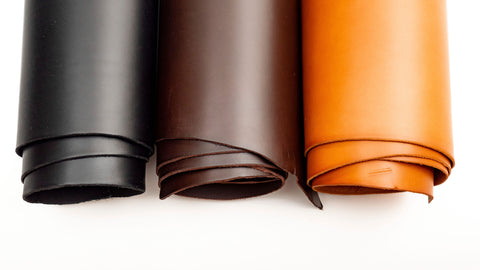Tanning methods explained - Four ways to create your leather

Tanning is the process of turning hides into a usable product. There are countless methods for this and each tannery uses its own unique methods and raw materials. If you would like to know for yourself with which products your leather is made, you will soon learn that this information is not easy to find. At Leatherbox we always strive for transparency and are happy to help you make the choices that suit your preferences. That is why you will find as much information as possible about the tanning method(s) used in each collection*.
There are many tanning methods, but we distinguish four in the Leatherbox webshop: vegetable tanned leather, chrome-tanned leather, chrome-free tanned leather and semi-vegetable tanned leather.
What is vegetable tanned leather?
Originally, this is the most traditional way of tanning leather. Modern tanneries have developed this method over time with nature as inspiration. Plant bark, roots, flowers, fruits and other natural antioxidants are the foundation for making the most beautiful leather collections. Vegetable tanned leather is generally a bit stiffer than chrome tanned leather and slightly more sensitive to sunlight. Many hand-stitched leather workers prefer vegetable-tanned leather because of its stiffness and artisanal appearance. The leather is also popular for classic leather processing among saddleries, for classic chairs or tool covers, for example.
Check out the collections of vegetable tanned leather from Leatherbox here
What is chrome tanned leather?
The vast majority of leathers are tanned with chromium (chrome 3), a safe substance that can also be found within our food. Chrome tanned leather sometimes has a negative reputation. In our opinion this needs some further explanation. This tanning method is not necessarily less sustainable than other tanning methods. For example, much less water is needed during production than with vegetable tanned leather. This also makes it a faster and cheaper tanning method. Chrome tanned leather is characterized by deep colours, suppleness and a final product that remains beautiful for a long time. For people with a chrome allergy, we recommend not using chrome tanned leather for accessories that come into direct contact with the skin, such as shoe linings, clothing, jewelry and bracelets or watch straps.
Check out Leatherbox's collections of chrome-tanned leather here
What is semi-vegetable tanned leather?
Semi-vegetable tanned leather means that several tanning methods have been combined. The advantages and good properties of the different methods are thus brought together in one product. Semi-vegetable tanned leather means that vegetable tanning agents have been used in combination with non-vegetable methods. This may mean that chrome-tanned leather is the base. Glutaraldehyde is also widely used. This is a synthetic, metal-free tanning method. Do you want to know which methods have been used for a semi-vegetable leather collection from Leatherbox? Then read the specifications on the product page under the heading 'Composition'.
Check out the collections of semi-vegetable tanned leather from Leatherbox here
What is chrome-free tanned leather?
Chrome-free tanned leather means that tanning methods have been used that do not use chromium. All vegetable tanned leather collections are automatically chrome-free. This is not always the case with semi-vegetable leathers. Vegetable tanning can be used in combination with chrome tanning. Nowadays there are also tanning methods in which the chromium has been replaced by other metals. At Leatherbox you will find more information about the tanning method in the specifications for each collection.
Check out the collections of chrome-free tanned leather from Leatherbox here
Each tanning method provides its own unique properties. Choose what suits your needs and application for the best result. And do you have questions? Of course we are happy to help you.
*The information about applied tanning methods and the composition is based on the information we receive from our suppliers.












